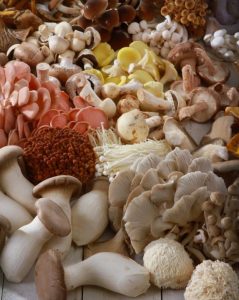The cows line up, waiting for their turn on the milking stand—except when a certain little troublemaker is involved.
Grandma Cow just had a calf, but here’s the twist—her grown-up daughter from two years ago also had a calf at the same week.
You’d think Grandma would be doting on her own baby, but nope.
Instead, she’s completely smitten with her daughter’s calf. And so is her daughter.
This little calf must have some kind of magic charm because now, instead of following their usual routine, both mama and grandma are obsessed with this one baby. They follow him everywhere, ignoring their own needs—and ours.
And here’s where it gets tricky: this little rascal is fast. When it takes off running, the two mamas go right after it, completely forgetting about their job—getting milked. Picture two big, lumbering cows trying to keep up with a speedy little calf, while we stand there, hands on hips, waiting for them to come back.
It’s a chase. It’s a comedy.
It’s a perfect example of that your food has a story.
Want to meet the little troublemaker and his devoted followers? I took a trip up to the barn to capture the action.
Watch this quick video to meet them and learn why their milk is something special.
Yes, it takes extra labor to raise our healthy cows and calves to produce fresh, local grass fed milk for you.
Sometimes it’s a hassle.
But our health and the pure enjoyment drinking it’s own reward.
“The biggest change I made in my diet that helped heal my gut and get the healthiest I’ve been in decades? Drinking your milk!” Bonnie, farm member, told me a few weeks ago.
If you love grass fed whole milk with the cream on top, why not make sure you always have it on hand? Our subscriptions guarantee you fresh farm milk every week—no running out!
This week get free farm-made fromage blanc when you subscribe to milk in your market box. What is “fromage blanc”? Similar to cream cheese it is a soft spreadable cheese often spread on bread, crackers, used for savory dips or sweetened for dessert with dried or fresh fruit.
MEAL IDEAS FOR YOUR LOCAL ORGANIC FOOD THIS WEEK:
Pro tip: Always check your recipes to see what you have and what you need to purchase. Takes a few extra minutes in planning, but it beats finding out at the last minute that you’re missing ingredients!
FEATURE: CARROTS
Carrots are super versatile – they can be eaten raw, fermented, roasted, glazed, or steamed. Check out some of the unique ways we’ve found to use these nutrition powerhouses.
Appetizers:
- Carrot Carpaccio – Thinly sliced carrots marinated in olive oil, lemon juice, salt, and a touch of honey, then topped with fresh herbs and shaved Parmesan.
- Carrot Tartare – Finely diced carrots mixed with capers, mustard, olive oil, and shallots, served with crackers or toast.
- Dukkah-Crusted Carrots – Dip raw carrot sticks in yogurt, then roll in dukkah (a nut and spice blend) for a crunchy, flavorful appetizer or snack.
Main dishes:
- Use a spiralizer to make Carrot Noodles with Spicy Peanut Dressing for a meatless lunch option or as a side.
- Tip: You can also use a vegetable peeler to shave the carrots into wide ribbons.
- Tip: Use tahini or your favorite nut butter for a peanut-free option.
- Five ingredients, spices, and 40 minutes is all you need to make this flavorful Moroccan Spiced Carrot Chickpea Stew.
- Looking for a light pasta meal? Try this Angel Hair Pasta with Walnut-Carrot Sauce.
Sides:
- Red-Miso-Glazed Roasted Carrots have a deep umami flavor and a buttery finish.
- Tip: White miso works just as well here.
- Make a Carrot and Farro Pilaf – Mix shredded carrots with cooked farro, herbs, and toasted nuts.
- Tip: Swap farro for rice, quinoa, or another grain of your choice.
- Carrot, Date, and Feta Salad is a little sweet and a little crunchy. Try it as a side or as a sandwich topper!
- For a new twist on traditional coleslaw, use rainbow carrots instead of cabbage to make this vibrant Carrot-Mustard Slaw.
- Carrot & Apple Salad – Grated carrots with julienned apple, lemon juice, olive oil, and toasted nuts.
Dessert and Baking:
- Carrot Cake Cheesecake Crumble Bars – Crumbly spiced carrot cake with a cheesecake center. Yum!
- Carrot Halwa (Gajar Ka Halwa) – A cozy Indian dessert of slow-cooked carrots, milk, and cardamom.
- Carrot Cake Biscotti – Spiced, crunchy, crumbly, and perfect for dipping! Serve with a drizzle of white chocolate for a bit of extra sweetness.
- Spiced Orange and Carrot Whole Wheat Muffins are bright and citrusy. Perfect for an on-the-go breakfast!
- Make Carrot Corn Muffins instead of traditional cornbread. The carrot adds a bit of sweetness and moisture to traditional cornbread. (And the maple butter looks amazing!)
Beverages:
- Make this Banana Carrot Smoothie for a quick, healthy breakfast that tastes like dessert!
- Try a Carrot Cold Brew Latte – Mix cold brew with carrot juice, cinnamon, and your favorite milk for a fun twist.
FEATURE: ORGANIC PASTURED CHICKEN
Many of these recipes include produce or other items you may have received in your market box. You may also see ingredients you can purchase from our online store or at the WHF General Store. Experiment and see what you can use to create your meal plan!
Whole Chicken:
- The colors and flavors of Roasted Chicken with Allspice and Citrus (Sheet Pan) can brighten up any chilly kitchen. This weeknight-friendly dinner is a great way to use your winter citrus.
- Tip: For this recipe, you can use a whole chicken cut into pieces, bone-in legs and breasts, or choose just your favorite pieces.
- If you love a good sausage and peppers sandwich, try this fun Roast Chicken with Sausage and Peppers. You get all the classic flavor of sausage and peppers plus the nourishing goodness of pastured chicken. If you have leftovers, make sausage and pepper sandwiches!
- Tip: Your WHF sausage is the obvious partner here!
- For Roast Chicken with Salsa Verde and Roasted Lemons, you can make your salsa verde as per the recipe or use a jar of your favorite as a shortcut.
- One Pot Chicken with Lemon Orzo is simple, cozy, and mostly hands-off cooking. And the recipe is very forgiving so you can adapt based on what’s in your kitchen.
- And don’t forget Tessa’s feature from last week’s blog on ways to use your whole chicken for 3 meals! Cook once and eat all week!
Chicken Legs:
- This easy recipe for Sheet Pan Curried Chicken Legs also includes carrots and green beans so your veggies are covered! The red curry paste is super flavorful but not too hot. Serve with cooked rice and lime wedges.
- Who doesn’t love a casserole? Spend just ten minutes of prep time and this Baked Chicken Legs and Rice meal practically cooks itself. Serve with a simple green salad or your favorite roasted veggies. Try asparagus, broccoli, or green beans.
- Tip: You can roast your veggies at the same temp while the rest of the meal is baking.
- These Slow Cooker BBQ Chicken Legs are a foolproof weeknight dinner solution. Serve with mac and cheese and a side of pickles, mashed potatoes and corn, coleslaw and cornbread, or a simple green salad with a tangy vinaigrette dressing.
- Tip: Use leftovers off the bone for chicken sliders or chicken salad.
Chicken Livers:
- Chicken Livers with Bacon, Onion, and Mushroom Sauce can be made in one pan and is ready in just 20 minutes. Serve over eggs or toast for breakfast or over mashed potatoes or root veggies for dinner.
- Tip: You can find bacon, onion, and mushrooms in our online store on at the general store.
- Sautéed Chicken Livers in White Wine Sauce is an easy main dish. Serve with your favorite potato recipe and a salad.
- Chicken Liver Pâté is a classic party appetizer. This version is simple and easy to make. The bright, salty flavor of capers adds a nice balance to the richness of the livers. Serve with your favorite crackers or slices of sourdough baguette.
- Crispy Fried Chicken Livers – Toss in seasoned flour or cornmeal and fry until crispy. Serve with a spicy dipping sauce.
- Chicken Liver Tacos – Marinate in lime juice and spices, then sear and serve with onions, cilantro, and salsa.
BREAD:
- Add a loaf of sourdough bread to your order to soak up the delicious sauces from your roast chicken meals.
- Serve your chicken liver pâté on toasted slices of sourdough baguette.
DAIRY:
- Make sure you have milk on hand to make a carrot halwa or carrot cold brew latte.
- Add a roll of Amish country butter to your market box for making glazed carrots or the delicious maple butter in the corn muffin recipe. (See above!)
MEAT and SEAFOOD:
- Since we’re featuring all of these delicious chicken recipes, you’ll definitely want to purchase chicken! Check out all of our pastured chicken options.
- If you don’t already have our pastured sausage in your freezer, add some to your order for making chicken with sausage and peppers (above).
PANTRY RECOMMENDATIONS:
- We have capers in the general store. Use them for the carrot-mustard slaw or chicken liver pâté.
- A jar of tomatillo salsa or salsa verde makes a great shortcut for the chicken with salsa verde and lemon recipe.
- Review your meal plan and then check your pantry for cooking/baking supplies – flour, baking powder, spices, sugars, maple syrup, oats, farro, nuts, etc.
FRUIT:
Storage for all apple varieties:
Keep unwashed apples in a plastic bag in the refrigerator’s crisper drawer, where they can stay fresh for up to two weeks.
 Apple, Fuji – Fuji apples are sweet, crisp, and juicy, with a dense texture, making them a popular snacking apple. They are rich in dietary fiber, vitamin C, and antioxidants, which support digestion, immune health, and skin vitality. Fuji apples can be eaten fresh, added to salads, baked into desserts, or cooked into sauces.
Apple, Fuji – Fuji apples are sweet, crisp, and juicy, with a dense texture, making them a popular snacking apple. They are rich in dietary fiber, vitamin C, and antioxidants, which support digestion, immune health, and skin vitality. Fuji apples can be eaten fresh, added to salads, baked into desserts, or cooked into sauces.
 Apples, Golden Delicious – Golden Delicious apples are a versatile variety with a sweet, mellow flavor and a crisp yet tender texture. They are high in fiber, vitamin C, and antioxidants, which support digestion, immune health, and skin health. These apples retain their shape and flavor, making them excellent for eating fresh, baking pies, making sauces, or adding to salads.
Apples, Golden Delicious – Golden Delicious apples are a versatile variety with a sweet, mellow flavor and a crisp yet tender texture. They are high in fiber, vitamin C, and antioxidants, which support digestion, immune health, and skin health. These apples retain their shape and flavor, making them excellent for eating fresh, baking pies, making sauces, or adding to salads.
 Apples, Stayman – This late-season apple variety is known for its firm texture and spicy, tart flavor with a hint of sweetness. They are high in fiber, vitamin C, and antioxidants, supporting immune health, digestion, and skin health. Stayman apples are excellent for fresh eating and ideal for baking, sauces, and cider, as their flavor intensifies when cooked.
Apples, Stayman – This late-season apple variety is known for its firm texture and spicy, tart flavor with a hint of sweetness. They are high in fiber, vitamin C, and antioxidants, supporting immune health, digestion, and skin health. Stayman apples are excellent for fresh eating and ideal for baking, sauces, and cider, as their flavor intensifies when cooked.
 Grapefruit – Grapefruit is a citrus fruit known for its juicy, tangy-sweet flavor with a slight bitterness. It is rich in vitamin C, fiber, and antioxidants like lycopene, promoting immune health, heart health, and skin health. Grapefruit can be eaten fresh, added to salads, or juiced for a refreshing drink. Store whole grapefruit at room temperature for up to a week or in the refrigerator for up to three weeks.
Grapefruit – Grapefruit is a citrus fruit known for its juicy, tangy-sweet flavor with a slight bitterness. It is rich in vitamin C, fiber, and antioxidants like lycopene, promoting immune health, heart health, and skin health. Grapefruit can be eaten fresh, added to salads, or juiced for a refreshing drink. Store whole grapefruit at room temperature for up to a week or in the refrigerator for up to three weeks.

Lemon – Lemons are tangy citrus fruits packed with vitamin C, antioxidants, and citric acid, which aid digestion, boost immunity, and enhance skin health. They are commonly used to add flavor to beverages, marinades, dressings, and desserts or as a natural cleaning agent. Store lemons at room temperature if using them soon or refrigerate them in a perforated bag to extend their shelf life up to 3-4 weeks.
 Orange, Mandarin – These small, sweet citrus fruits have a thin, easy-to-peel skin. They are high in vitamin C, fiber, and flavonoids, supporting immune function, digestion, and heart health. Mandarins are perfect for snacking, adding to desserts, or tossing into salads. Store them at room temperature for a few days or refrigerate to extend freshness for up to two weeks.
Orange, Mandarin – These small, sweet citrus fruits have a thin, easy-to-peel skin. They are high in vitamin C, fiber, and flavonoids, supporting immune function, digestion, and heart health. Mandarins are perfect for snacking, adding to desserts, or tossing into salads. Store them at room temperature for a few days or refrigerate to extend freshness for up to two weeks.
 Orange, Navel – Navel oranges are sweet, seedless, and easy to peel, making them an excellent snack or addition to salads and desserts. They are high in vitamin C, fiber, and antioxidants, which promote immune health and support heart health. Store navel oranges at room temperature for up to a week or refrigerate them in a mesh bag for up to three weeks to maintain freshness. Wash before peeling or slicing.
Orange, Navel – Navel oranges are sweet, seedless, and easy to peel, making them an excellent snack or addition to salads and desserts. They are high in vitamin C, fiber, and antioxidants, which promote immune health and support heart health. Store navel oranges at room temperature for up to a week or refrigerate them in a mesh bag for up to three weeks to maintain freshness. Wash before peeling or slicing.
 Mango – This tropical fruit is known for its juicy, sweet, and slightly tangy flavor. It’s rich in vitamin C, vitamin A, and fiber, supporting immune health, vision, and digestion. Mangoes can be eaten fresh, blended into smoothies, added to salsas, or used in desserts. Store unripe mangoes at room temperature until they soften, then refrigerate ripe ones for up to a week.
Mango – This tropical fruit is known for its juicy, sweet, and slightly tangy flavor. It’s rich in vitamin C, vitamin A, and fiber, supporting immune health, vision, and digestion. Mangoes can be eaten fresh, blended into smoothies, added to salsas, or used in desserts. Store unripe mangoes at room temperature until they soften, then refrigerate ripe ones for up to a week.
Fun Fact: Mangoes belong to the same plant family as cashews and pistachios!
 Pear, Bosc – Bosc pears are a brown-skinned pear variety known for their dense, crisp texture and sweet, slightly spicy flavor. They are high in dietary fiber, vitamin C, and potassium, supporting digestion, immune health, and heart function. Bosc pears are excellent for eating fresh, baking, poaching, or adding to salads, as they hold their shape well when cooked. Store unripe Bosc pears at room temperature until they soften slightly, then refrigerate to maintain freshness for up to a week.
Pear, Bosc – Bosc pears are a brown-skinned pear variety known for their dense, crisp texture and sweet, slightly spicy flavor. They are high in dietary fiber, vitamin C, and potassium, supporting digestion, immune health, and heart function. Bosc pears are excellent for eating fresh, baking, poaching, or adding to salads, as they hold their shape well when cooked. Store unripe Bosc pears at room temperature until they soften slightly, then refrigerate to maintain freshness for up to a week.
Organic Veggies We Harvested This Week:
To help you use everything in your box this week, use this Meal Planning Guide to keep track of what’s in the fridge, what needs to be used first, and what you have planned or prepped for each day.
Every member’s customized Market Box is unique so we hope you will take advantage of more varieties of vegetables as you get comfortable with all the great organic produce we are offering.
Tessa’s Tips
What to use first: pears, greens, mushrooms
Longest Storage: apples, beets, carrots, Jerusalem artichokes, potatoes
Pro-tip: Look at the items in your market box right away and decide how you will use them in your meal planning for the week. Freeze any veggies you know you won’t be able to eat in the week.

Arugula – This leafy green has a peppery, slightly bitter flavor and is commonly used in salads, sandwiches, and as a garnish. It is low in calories and packed with vitamins A, C, and K, as well as folate and antioxidants, which support eye health, immune function, and bone strength. Arugula can be eaten fresh or lightly wilted in pasta dishes and pizzas. Some prefer to eat it tossed with other fresh greens or lettuce so that the spicy taste is not as strong. Putting it on a sandwich is another delicious way to enjoy its distinct flavor. Store wrapped in a paper towel inside a loosely sealed plastic bag in the refrigerator crisper drawer. Properly stored, arugula can stay fresh for up to 3-5 days. For best quality, use arugula soon after purchasing.
Arugula isn’t just for salad. Here are 29 Ways to Eat Arugula including pasta dishes, pizza, sandwiches, and more.
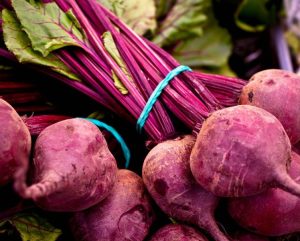
Beet, Red – Red beets are root vegetables known for their earthy flavor and vibrant red-purple color. They are rich in nutrients like folate, manganese, potassium, dietary fiber, and antioxidants such as betalains, which help reduce inflammation and support heart health. Both the roots and greens are edible, with the greens offering additional nutrients like vitamins A and C. Beets can be eaten raw in salads, roasted, boiled, or blended into smoothies and soups. Store beet greens separately from the root, wrapped in a damp cloth or in a plastic bag in the fridge. Use within a few days – they don’t keep long. Beetroots can be stored in a plastic bag in the fridge’s crisper drawer for up to two weeks. To freeze beets for longer storage, slice or chop them, spread on a cookie sheet to flash freeze, then transfer to freezer bags where they can be stored for up to a year.
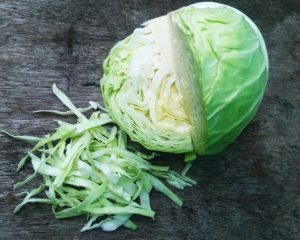 Cabbage, Green – Green cabbage is a nutrient-dense cruciferous vegetable in the Brassica family, known for its tightly packed, round, pale green leaves. It is rich in vitamins C and K, as well as fiber and antioxidants, which are beneficial for immune health, digestion, and bone strength. With a mild, slightly peppery taste, green cabbage can be enjoyed raw in salads and slaws, or cooked in stir-fries, soups, and stews. To store, keep green cabbage unwashed in a perforated plastic bag in the refrigerator’s crisper drawer, where it can stay fresh for up to two weeks.
Cabbage, Green – Green cabbage is a nutrient-dense cruciferous vegetable in the Brassica family, known for its tightly packed, round, pale green leaves. It is rich in vitamins C and K, as well as fiber and antioxidants, which are beneficial for immune health, digestion, and bone strength. With a mild, slightly peppery taste, green cabbage can be enjoyed raw in salads and slaws, or cooked in stir-fries, soups, and stews. To store, keep green cabbage unwashed in a perforated plastic bag in the refrigerator’s crisper drawer, where it can stay fresh for up to two weeks.
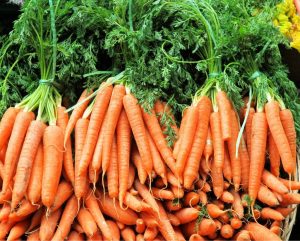 Carrot – Carrots are a versatile and popular root vegetable, known for their sweet, crunchy texture and vibrant orange color, though they can also be found in purple, yellow, and red varieties. They are rich in beta-carotene, which the body converts to vitamin A, essential for good vision and immune health. Carrots are a good source of dietary fiber, potassium, and antioxidants. Enjoy them raw, cooked, roasted, or juiced. They can be used in salads, soups, stews, and side dishes. For optimal storage, store carrots unwashed in the fridge, preferably in a plastic bag or container to maintain moisture, where they can last for several weeks. If the greens are attached, cut them off to prevent the carrots from becoming limp. Stored properly, they should last around 1-2 weeks.
Carrot – Carrots are a versatile and popular root vegetable, known for their sweet, crunchy texture and vibrant orange color, though they can also be found in purple, yellow, and red varieties. They are rich in beta-carotene, which the body converts to vitamin A, essential for good vision and immune health. Carrots are a good source of dietary fiber, potassium, and antioxidants. Enjoy them raw, cooked, roasted, or juiced. They can be used in salads, soups, stews, and side dishes. For optimal storage, store carrots unwashed in the fridge, preferably in a plastic bag or container to maintain moisture, where they can last for several weeks. If the greens are attached, cut them off to prevent the carrots from becoming limp. Stored properly, they should last around 1-2 weeks.

Carrot, Rainbow – In addition to the nutritional benefits above, rainbow carrots stand out from standard orange carrots with their vibrant colors—purple, yellow, red, and white—each offering unique nutritional benefits and distinct flavors. Purple carrots contain anthocyanins, powerful antioxidants linked to anti-inflammatory and heart-health benefits, with a slightly earthy, spicy taste. Yellow carrots are rich in lutein, which promotes eye health by protecting against macular degeneration and cataracts, and they have a mild, subtly sweet flavor. Red carrots contain lycopene, a potent antioxidant that supports heart health, reduces the risk of certain cancers, and helps protect skin from UV damage, with a richer, sweeter taste.
These colorful carrots are perfect for adding visual appeal to dishes and enhancing the taste profile, whether roasted to bring out their natural sweetness, or sliced raw for salads. Their distinct flavors can also add depth to juices and smoothies. The diverse hues, flavors, and nutrients of rainbow carrots make them perfect for garnishes or serving as part of a vegetable medley. Store rainbow carrots the same way you would store standard orange carrots.
Celery – Celery is a crunchy, low-calorie vegetable known for its mild, slightly salty flavor. It is rich in vitamins K and C, folate, potassium, and fiber, supporting bone health, digestion, and hydration. Celery is often eaten raw as a snack, added to salads, or used as a base in soups, stews, and stir-fries. Store celery in the refrigerator, tightly wrapped in aluminum foil to retain its crispness, where it can stay fresh for up to two weeks. For longer storage, celery can be chopped and frozen.
Don’t forget to use those celery greens! They’re a great addition to cooked beans, salads, eggs. Use leaves to make pesto or dry them and make your own parsley flakes, powder, or salt.
Ginger – Ginger is a flavorful root widely used as a spice and natural remedy. It has a warm, slightly spicy taste and is rich in bioactive compounds like gingerol, which has anti-inflammatory and antioxidant properties. Ginger aids digestion, relieves nausea, and supports immune health. It is versatile in cooking, and used in teas, curries, stir-fries, baked goods, and beverages. Store fresh ginger in a cool, dry place for short-term use or in the refrigerator in a paper towel or airtight bag for extended freshness. For long-term storage, freeze peeled or sliced ginger.
Freeze your fresh ginger for longer storage: Peel and slice or grate the ginger. Freeze in an airtight container or ice cube tray. You can also freeze the whole unpeeled root in a freezer bag. Grate or slice directly from frozen as needed.
 Dandelion Greens – These nutrient-packed leafy greens are rich in vitamins A, C, and K, as well as calcium, iron, and antioxidants. Slightly bitter with a nutty undertone, they are great in salads, sautéed as a side dish, blended into smoothies or soups, or even used as a pizza topping. To store, keep them unwashed in a plastic bag or container lined with paper towels in the fridge, and use within 3–5 days for peak freshness.
Dandelion Greens – These nutrient-packed leafy greens are rich in vitamins A, C, and K, as well as calcium, iron, and antioxidants. Slightly bitter with a nutty undertone, they are great in salads, sautéed as a side dish, blended into smoothies or soups, or even used as a pizza topping. To store, keep them unwashed in a plastic bag or container lined with paper towels in the fridge, and use within 3–5 days for peak freshness.
 Kale – Curly kale is a nutrient-dense leafy green rich in vitamins A, C, and K, along with fiber, antioxidants, and minerals like calcium and potassium. It has a slightly bitter, peppery flavor and a sturdy texture that softens when massaged, cooked, or blended. Curly kale is great in salads, soups, sautés, smoothies, and as a base for grain bowls. Store unwashed leaves in a loose bag in the fridge’s crisper drawer, ideally wrapped in a damp paper towel, and use within 5–7 days. To keep it fresh longer, blanch and freeze it for later use in cooked dishes.
Kale – Curly kale is a nutrient-dense leafy green rich in vitamins A, C, and K, along with fiber, antioxidants, and minerals like calcium and potassium. It has a slightly bitter, peppery flavor and a sturdy texture that softens when massaged, cooked, or blended. Curly kale is great in salads, soups, sautés, smoothies, and as a base for grain bowls. Store unwashed leaves in a loose bag in the fridge’s crisper drawer, ideally wrapped in a damp paper towel, and use within 5–7 days. To keep it fresh longer, blanch and freeze it for later use in cooked dishes.
Mushroom Varieties
Store mushrooms in a paper bag or breathable container in the refrigerator, avoiding moisture buildup, and only wash them right before use to maintain freshness.
Mushrooms are super versatile in the kitchen. Here are 10 Things You Should Do With Mushrooms.
This roundup of 20 Mushroom Recipes has you covered with meal ideas for breakfast, lunch, or dinner.
Mushroom, Portobello & Cremini – Portobello mushrooms are mature versions of cremini mushrooms, offering a meaty texture and rich, earthy flavor. Cremini, also known as “baby bellas,” are younger, smaller, and have a firmer texture with a milder taste. Both are low in calories, fat-free, cholesterol-free, and provide B vitamins, selenium, potassium, and antioxidants. Portobellos are ideal for grilling, roasting, or as a meat substitute in burgers, sandwiches, or stuffed recipes. Creminis are great for sautéing, adding to soups, stir-fries, pasta dishes, or as pizza and salad toppings.
Mushroom, Shiitake – Shiitake mushrooms are prized for their rich, umami flavor and slightly chewy texture, making them a staple in Asian cuisine. They are low in calories, fat-free, and a good source of B vitamins, copper, selenium, and immune-supporting polysaccharides. Shiitakes are versatile and can be sautéed, stir-fried, grilled, or added to soups, stews, and sauces for a depth of flavor. They are popular in dishes like ramen, risotto, and dumplings, and are often used in vegetarian recipes for their meaty texture.
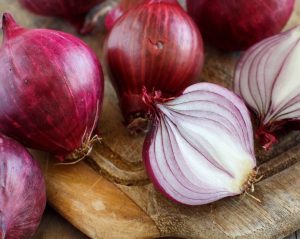 Onion, Red – Red onions are a vibrant, mildly sweet onion variety with a sharp bite, commonly used raw or cooked in various dishes. They are a good source of vitamin C, antioxidants, and fiber, contributing to overall health and supporting the immune system. Red onions add color and flavor to salads, salsas, sandwiches, pickles, and roasted vegetable dishes. Store whole red onions in a cool, dry, well-ventilated space away from sunlight; once cut, refrigerate in an airtight container and use within a few days to preserve freshness.
Onion, Red – Red onions are a vibrant, mildly sweet onion variety with a sharp bite, commonly used raw or cooked in various dishes. They are a good source of vitamin C, antioxidants, and fiber, contributing to overall health and supporting the immune system. Red onions add color and flavor to salads, salsas, sandwiches, pickles, and roasted vegetable dishes. Store whole red onions in a cool, dry, well-ventilated space away from sunlight; once cut, refrigerate in an airtight container and use within a few days to preserve freshness.
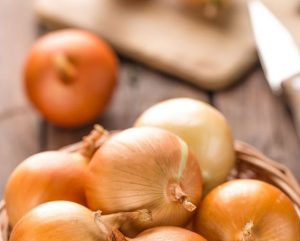
Onion, Yellow – Yellow onions are a popular, versatile vegetable with golden-brown skin and a strong, savory flavor that mellows and sweetens when cooked. Rich in antioxidants, vitamin C, and fiber, yellow onions support immune health, digestion, and overall cellular health. They’re a staple in many cuisines, perfect for sautéing, caramelizing, roasting, and adding depth to soups, stews, and sauces. To store, keep unpeeled yellow onions in a cool, dry, well-ventilated place, away from potatoes, where they can last up to a month; once peeled or cut, store them in an airtight container in the refrigerator for up to a week.
Parsley, Flat Italian – Parsley is a popular herb with bright green leaves and a fresh, slightly peppery flavor. It is rich in vitamins A, C, and K, along with folate and antioxidants, which support immune health, bone health, and digestion. Parsley is used as both a garnish and a key ingredient in various dishes. It is commonly used in Mediterranean and Middle Eastern cuisines, adding flavor to salads, soups, sauces, and marinades. Store as you would any herb; in a glass with some water on the counter. Keep for several days. For longer storage, parsley can be chopped and frozen in airtight containers or ice cube trays.
 Potato, Yellow – Also known as Yukon Gold or gold potatoes, yellow potatoes have smooth, thin, yellowish skin and creamy, buttery-flavored flesh. They are slightly waxy, making them versatile in cooking. Yellow potatoes are a good source of vitamin C, potassium, and fiber and are low in calories and fat. Their creamy texture makes them ideal for mashing, roasting, grilling, and boiling. They are also excellent in gratins and salads because they hold shape during cooking. Store yellow potatoes in a cool, dark, and well-ventilated place for several weeks, avoiding refrigeration as it can alter their texture and flavor.
Potato, Yellow – Also known as Yukon Gold or gold potatoes, yellow potatoes have smooth, thin, yellowish skin and creamy, buttery-flavored flesh. They are slightly waxy, making them versatile in cooking. Yellow potatoes are a good source of vitamin C, potassium, and fiber and are low in calories and fat. Their creamy texture makes them ideal for mashing, roasting, grilling, and boiling. They are also excellent in gratins and salads because they hold shape during cooking. Store yellow potatoes in a cool, dark, and well-ventilated place for several weeks, avoiding refrigeration as it can alter their texture and flavor.
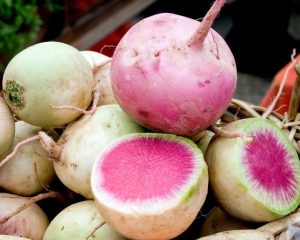 Radish, Watermelon – Watermelon radish is a striking root vegetable with a mild, slightly sweet flavor and a crisp texture. Its pale green skin hides a vibrant pink interior, resembling a watermelon. Rich in vitamin C, potassium, and antioxidants, it supports immune health and reduces inflammation. Watermelon radishes can be enjoyed raw in salads, sliced thinly for garnishes, pickled, or roasted for a milder flavor. Store unwashed watermelon radishes in a perforated plastic bag in the refrigerator, where they can stay fresh for up to two weeks. Wash and trim just before using.
Radish, Watermelon – Watermelon radish is a striking root vegetable with a mild, slightly sweet flavor and a crisp texture. Its pale green skin hides a vibrant pink interior, resembling a watermelon. Rich in vitamin C, potassium, and antioxidants, it supports immune health and reduces inflammation. Watermelon radishes can be enjoyed raw in salads, sliced thinly for garnishes, pickled, or roasted for a milder flavor. Store unwashed watermelon radishes in a perforated plastic bag in the refrigerator, where they can stay fresh for up to two weeks. Wash and trim just before using.
 Rutabaga – Rutabaga is a round, root vegetable with yellowish flesh and a mildly sweet, earthy flavor. It is packed with fiber, vitamin C, and potassium, supporting digestion, immune health, and heart function. Rutabaga is excellent roasted, mashed, added to soups, or used in stews. Rutabaga can be thinly sliced and baked into crispy chips or grated and mixed into coleslaw for a unique twist. Its slightly sweet flavor also works wonderfully in casseroles or mixed with mashed potatoes for added depth. Store rutabaga in a cool, dark place or in the refrigerator, where it can stay fresh for several weeks.
Rutabaga – Rutabaga is a round, root vegetable with yellowish flesh and a mildly sweet, earthy flavor. It is packed with fiber, vitamin C, and potassium, supporting digestion, immune health, and heart function. Rutabaga is excellent roasted, mashed, added to soups, or used in stews. Rutabaga can be thinly sliced and baked into crispy chips or grated and mixed into coleslaw for a unique twist. Its slightly sweet flavor also works wonderfully in casseroles or mixed with mashed potatoes for added depth. Store rutabaga in a cool, dark place or in the refrigerator, where it can stay fresh for several weeks.
Fun Facts: Rutabagas are a cross between a turnip and a cabbage, giving them their unique flavor. Rutabaga is also known as swede which is short for “Swedish turnip.”
 Sweet Potato – Sweet potatoes are a nutritious root vegetable known for their naturally sweet flavor and vibrant orange flesh, though they also come in other colors like purple and white. They are rich in vitamins A (as beta-carotene), C, and B6, as well as dietary fiber, potassium, and antioxidants. These nutrients support eye health, boost immunity, and promote digestive health. Sweet potatoes are versatile in cooking and can be baked, roasted, mashed, or used in soups and stews. They can also be enjoyed in both savory and sweet dishes. Store sweet potatoes in a cool, dark, well-ventilated place for several weeks, avoiding refrigeration as it can affect their texture and flavor.
Sweet Potato – Sweet potatoes are a nutritious root vegetable known for their naturally sweet flavor and vibrant orange flesh, though they also come in other colors like purple and white. They are rich in vitamins A (as beta-carotene), C, and B6, as well as dietary fiber, potassium, and antioxidants. These nutrients support eye health, boost immunity, and promote digestive health. Sweet potatoes are versatile in cooking and can be baked, roasted, mashed, or used in soups and stews. They can also be enjoyed in both savory and sweet dishes. Store sweet potatoes in a cool, dark, well-ventilated place for several weeks, avoiding refrigeration as it can affect their texture and flavor.
 Swiss Chard (baby) – Milder and more tender than mature Swiss chard, baby chard is often used raw in salads, wraps, or grain bowls. While still rich in vitamins A, C, and K, it may have slightly less fiber than its fully grown counterpart. Store in a sealed container with a dry paper towel in the fridge and use within 3–5 days for the best freshness.
Swiss Chard (baby) – Milder and more tender than mature Swiss chard, baby chard is often used raw in salads, wraps, or grain bowls. While still rich in vitamins A, C, and K, it may have slightly less fiber than its fully grown counterpart. Store in a sealed container with a dry paper towel in the fridge and use within 3–5 days for the best freshness.
Fun fact: Chard is in the chenopod family which includes beets, spinach, and quinoa.
Don’t Forget: Online shopping opens Friday at 3 PM! 🛒 Stock your kitchen with these clean, nourishing ingredients to fuel your family with nutrient-dense meals. Be sure to grab your favorite staples and try something new for vibrant health this winter.
Don’t wait to join…
Veggie E-Books
Download these collections of tips and recipes for each veggie. You’ll use these as a reference throughout the season.
Arugula E-Book
Beets E-Book
Cabbage E-Book
Carrots E-Book
Kale E-Book
Mushrooms E-Book
Onions E-Book
Potatoes E-Book
Radish E-Book
Swiss Chard E-Book
~~~~~
Farm News and Events
💪 Strong to the Core: Spring Fitness & Wellness Workshop 💪🌿

Feeling stiff? Lacking energy? Struggling with everyday movements?
It’s time to build strength where it matters most—your core!
Join us on Saturday, March 1, for a 2-hour group intro to fitness and wellness workshop designed to help you:
✔ Move with confidence in everyday life
✔ Improve flexibility, mobility, and core function
✔ Learn proper movement techniques to protect your body
✔ Keep muscles strong to support your bones as you age
Whether you’re lifting, bending, or just keeping up with life’s demands, this workshop will help you stay strong and mobile for years to come!
📩 Sign up today! In person at Willow Haven Farm General Store or email whfgeneralstore@gmail.com.
Know someone who could benefit? Tag a friend who wants to move better and feel stronger this spring! 🌱💪
~~~~~
💦 Intro to Hydration with Aga Kastelik – Health and Wellness Professional, Certified H2 Advisor with Molecular Hydrogen Institute
This introductory class explores the fundamental role of water in human health and introduces the emerging science of molecular hydrogen.
Join us on Saturday, March 8, 2025 from 11:00 AM to 12:00 noon to learn about:
- The biochemical functions of water in the body
- Hydration’s impact on cognitive function, physical performance, and cellular health
- How molecular hydrogen may offer unique therapeutic benefits
- The latest research on hydrogen’s potential as an antioxidant and signaling molecule
~~~~~
🍞 Next Sourdough Bread Baking Workshop – Sign Up!
Get ready for a fun, hands-on experience in the art of sourdough bread making!
Join us on Saturday, March 29, 2025, for our Sourdough Bread Baking Workshop at Willow Haven Farm.
Whether you’re a beginner or a seasoned baker, this workshop will give you the skills and confidence to bake delicious, homemade sourdough bread from scratch.

👩🍳 What to Expect on March 29th:
- Step-by-step guidance from our expert instructor
- Hands-on experience making your own sourdough starter
- Tips for perfecting your bread at home
- A chance to meet other bread enthusiasts in a fun, relaxed environment
✨ Don’t miss out on this opportunity to take your baking to the next level!
We’ll keep farming for you!
Reuben and Tessa DeMaster
Willow Haven Farm


